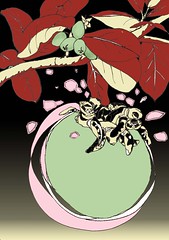
22 March-Turtle Hatchlings and a branch of the Sea Almond
J: [points at a tree] So what's this tree called?
Y: Er, it's...I don't know.
J: [points at a tree] And this?
Y: Eh, I saw it in the book! I think it's...I don't know.
J: [points at a tree] And this tree?
Y: I don't know.
J: [points at a tree] And this tree?
Y: I don't know.
J: [points at a tree] And this tree?
Y: I don't know.
Repeat ad nauseam.
This little book has gotten me looking at trees every time I step out. But I don't seem to quite have a head for botany. A "conical crown" and "compound leaves" are echoes of the Primary School science text book, abstractions that I recognise but cannot translate into what I'm seeing. The lives of the trees when described - some of them indigenous, many are migrants from the Americas, Africas or the immediate region around us - read a little like magical fiction and sometimes, like memory.
I like the Sea Almond. It is supposedly "a common seashore tree of the region, easily recognised by its pagoda shape of radiating branches growing at regular intervals along the stem. The tree sheds its leaves twice a year and before they are shed, the large, simple leaves turn vivid red". The fruits of the sea almond "have a corky layer which helps them float in the sea, this being their normal method of dispersal. The single seed has an edible embryo, tasting rather like almond, thus the common name."
Walking along a short stretch of road leading to my mother's house last evening, I think I came across more than 5 varieties of trees. There is one whose dried and open fruits always provide a satisfying crunch under the foot. There is some sort of palm - that much I know. There is a lone Frangipani on the traffic island at the Y-fork of the road. Then there are the tall, outstretched branches of a tree whose bloom and falling leaves have the same shade of yellow. And a tree whose bark is pale and whose crown is thin, but maybe its roots are deep.
The natural world would always inform and amaze with its abundance of form and colour, the inventiveness and genius of its making; and of course, God its maker.
I am not sure how this is related to nature's plenty, but with a year away from formal work and a global environment marked by economic shake-ups, I am thankful for being able to get back to a more grounded living. Perhaps I mean to say a more plentiful living.






No comments:
Post a Comment